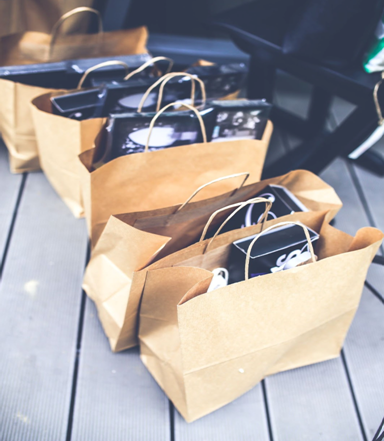Paper Bags And Their Effects On The Environment

Paper bags, whether as small as a single piece of paper or the large sacks seen in grocery stores, have a significant impact on the environment. The manufacturing process of paper bags began with creating a durable and reusable material. With all of the countries that produce paper products, one must take into account how these products impact the environment.
The Use of Paper Bags
Making a difference in the environment is something that paper sacks can do quite easily. When used properly, Plain paper bags can help to collect waste and recycle materials from the environment. Not only does this help reduce the amount of trash produced, but it also helps keep our planet clean. Brown and colored paper sacks are easy to use and can be filled with a variety of materials such as waste, recycling materials, or other small items. By using paper sacks, we are able to make a difference in the environment and save money on our environmental costs.
These paper bags aren’t just for meals or grocery shopping. Here are some other functions they have.
1. Collect Recycling
To collect all your recyclables, a paper bag is the best thing. You can use paper bags to transport newspapers, plastic bottles and other items to the recycling center. You can also recycle the paper bag!
2. Freshen Stale Bread
Has your bread already gone stale? You can freshen up your bread by placing it in a paper bag. Place a bit of water in the bag, then bake it. The bag steams and helps moisten the bread.
3. Compost
Brown compost materials are made from paper bags, which can be a good source of carbon. You can simply cut the paper bag into small pieces and add it to your compost pile. To collect materials for composting, you can also use the paper bag. You can also use paper bags to make compost.
4. Pack belongings
When packing for a move, brown paper bags are a great option. To pack your items securely in a container, you can use crumpled brown paper bags. You can pack items securely in a box by using crumpled up brown paper bags. This will prevent them from moving around, which decreases the chance of them breaking. The paper bag can be shredded and used as filler material.

5. Cool your cookies
When you take out freshly baked cookies from the oven, use a paper bag to cool them. The paper bag stops air from circulating around the cookies. This prevents moisture from circulating around the cookie, which helps preserve its crispiness. As the cookies cool, custom wax paper bags absorb any grease.
The Environmental Benefits of Using Paper Bags
1. Biodegradable
First, unlike plastic bags, paper bag waste won’t linger on the Earth’s surface for more than 1000 years. For the next 1000 to 10,000 year, humans won’t lose all marine animals in oceans, rivers, lakes and ponds due to plastic pollution. They may also not lose most of the land’s fertility to plastic topsoil. This is assuming that plastic packaging can be replaced with biodegradable paper packaging. Most paper bag waste is capable of degrading in less than six months and most often, it becomes fertile waste for plants.
2. Recyclable

Most paper bags can be recycled 100%. The paper recycling process is safer than plastic, which emits toxic and poisonous gases into the atmosphere . This is the main reason to use paper bags. Reusable paper bags are easy to recycle and don’t pollute. Both customers and business owners should encourage the reuse of paper bags.
3. Paper is an Energy Saver
Besides several benefits of using paper bags, one of the reasons why it is so environmentally-friendly is that it helps in saving huge amounts of energy. It is made of locally available materials which, in turn, helps in reducing transportation costs and ultimately saves energy.
4. Conservation of Natural Resources is made easier by paper bags.
Paper bags are a great way to reduce carbon emissions, save natural resources and energy. It is clear that eco-friendly options are needed to save the earth. Forging paper bags is one great way to do this. It is time to switch to eco-friendly paper bags.
These benefits are not only related to the environment. Paper bags can also protect your food items, as we have already mentioned. See some edible items where paper packaging can be a boon.
The Negative Impact of Using Paper Bags
1. Not waterproof.
The paper will become unusable if it is exposed to steam and liquid. Plastics can hold on to items even when they are wet.
2. Not as strong as plastic bags.
Paper bags have limitations when it comes packing heavy materials. Plastic bags can withstand liquids and are useful even in bad weather. Paper bags will deform when they are exposed to solutions. Baguette bread bags can become wet and rip if they are exposed to liquid syrup.
Read Also: Advantages and Disadvantages of Paper Bags Packaging seo friendly content writer
3. Requires more materials and is more expensive.
Plastic production is more polluting than paper bag production, emitting 70 more pollutants and water pollutants, and half as many. Paper production requires more water, greenhouse gases and chemicals. Producing papers requires more energy.
4. Use More Storage Space.
Paper bags weigh more than plastics so you will need more storage space, especially if your order is bulk. Shipping costs will be higher if the bags are shipped from overseas.
5. Trees Need to Be Cut
Americans use more than 10 Billion paper bags each year, which is equivalent to the cutting of 14 million trees to make paper.
Conclusion
In conclusion, paper bags are an effective way to reduce the amount of waste that is produced by businesses and individuals. However, careful planning and management of these bags can minimize their negative environmental effects.







